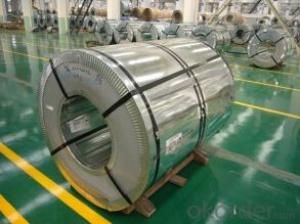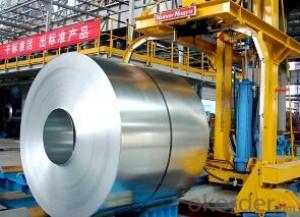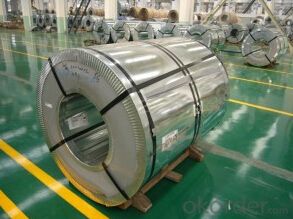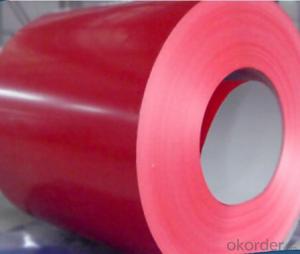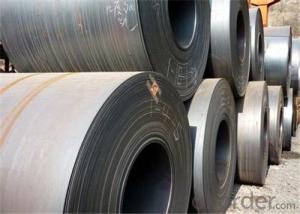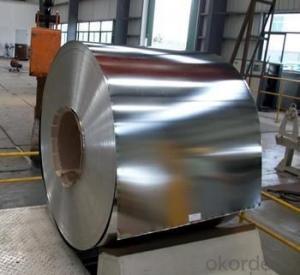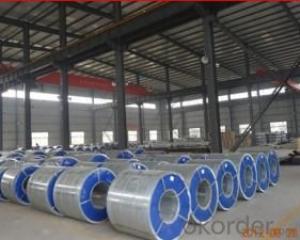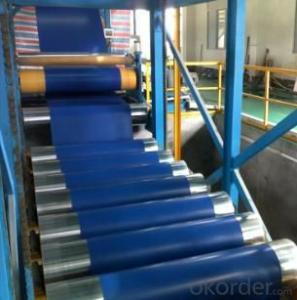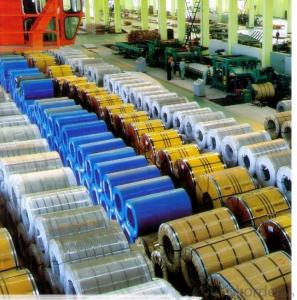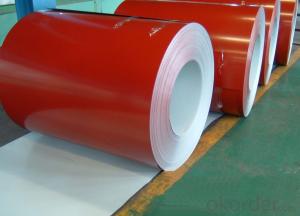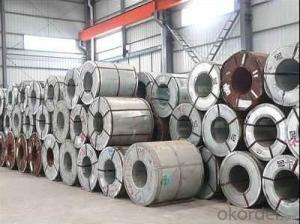304 Stainless Steel Coil for Construction
- Loading Port:
- Tianjin
- Payment Terms:
- TT OR LC
- Min Order Qty:
- 25 m.t.
- Supply Capability:
- 10000 m.t./month
OKorder Service Pledge
OKorder Financial Service
You Might Also Like
Description Basic Info.
Model NO.:2B, NO. 4, HL, SB, NO. 4+HL, NO. 4+SB, NO. 4+HL
Surface Treatment:2b, Ba, No.4, Hl, Sb, No.4+Hl, No.4+Sb, Hl+Sb
Certification:ISO, SGS
Technique:Cold Rolled, Hot Rolled
Standard:ASTM, JIS, GB, AISI, DIN, BS
Stock:Stock
Steel Grade:300series, 400series
Model No.:430, 409L, 304,316L,316/No.1,304/No.1,436L,439
Delivery Time:5-12 Days After Order Placed
Export Markets:Global
Additional Info.
Packing:Standard Export Packing
Origin:Tisco, Zpss, Baoxin, Baosteel, Qpss, Huayi
HS Code:7219339000
Production Capacity:4000-5000mt/Month
| Commodity: | stainless steel sheet, stainless steel coil, stainless steel circle, stainless steel strip |
| Material: | 304/2B, 430/2B/BA, 316L/2B, 409L/2B/2D, 316/NO.1, 304/NO.1, 436L/2B, 439/2B, 443/2B, 201/2B |
| Finished process: | NO.4, HL, NO.4+HL, SB, NO.4+SB, HL+SB, NO.4+HL+SB |
| Technique: | Cold Rolled / Hot Rolled |
| European imported stainless steel leveling grinding line: | (1) Material: SUS300 and 400 series, surface 2B, NO.1 (2) Finished Product: NO.4, HL, SB, NO.4+HL, NO.4+SB, HL+SB (3) Thickness: 0.5mm~8.0mm (4) Width: 600mm~1600mm |
| Imported high-strength trim leveling line for stainless steel: | (1) Material: Hot & Cold rolled stainless steel plate, High-strength stainless steel (2) Thickness: 3.0mm~16mm (3) Width: 700mm~2100mm (4) Cutting length: 1000mm-12000mm |
| Imported over-wide Slitting line: | (1) Material: SUS300 and 400 series stainless steel coils (2) Thickness: 0.6mm-6.0mm (3) Width: 500mm-2160mm |
| Imprted European coil oil polishing production line | (1) Finished Surface: NO.4, HL (2) Thickness: 0.4mm~2.5mm (3) Width: 500mm~1320mm |
| Italy SAMIS Disc-on-line press production line | (1) Material: Stainless Steel Circle (2) Finished circles: Φ200~Φ600 (3) Thickness: 0.4mm~2.0mm (4) Width: 600mm~1580mm |
| Imported Swap Atypia Leveling and flying Shear Machine: | (1) Material: Stainless Steel Sheet (2) Thickness: 0.3mm~3.0mm (3) Width: 400mm~1600mm (4) Finished Length: 400mm~6200mm (5) Leveling: Remove loose edges and flatten the materials |
| Imported small Flying Shear Machine: | (1) Material: Small plate (2) Thickness: 0.2mm~1.2mm (3) Width: 100mm~850mm (4) Finished Length: 201mm~2500mm (5) Applications: Good performance in processing auto parts, household appliances, kitchen ware and other related products. |
| 1600mm Imported Slitting Machine: | (1) Materials: Small width stainless steel coil (2) Thickness: 0.3mm~3.0mm (3) Width: 400mm~1600mm (4) The narrowest width of finished products: a. Below 22mm for thickness below 1.0mm . b. 31mm for thickness over 1.2mm. (5) Number of slices: Up to 32, and 9 slices of 3.0mm |
| Small Slitting Machine Line: | (1) Thickness: 0.2mm~1.5mm (2) Width: 10mm~650mm (3) Finished product: The narrowest width is 7mm for plate of below 0.9mm thickness and is 12mm for plate of above 0.9mm in thickness. |
| European imported Oil polishing machine: | (1) Materials: SUS300 and 400 series, 2B, NO.1 stainless steel (2) Thickness: 1.0~30mm (3) Width: 1000mm~2000mm |
| Standard: | AISI, ASTM, DIN, EN, GB, JIS, etc |
| Package: | (1) Export standard wooden packing (2) According to customers' requirement |
| Delivery: | (1) For coils T/T payment: immediately delivery. (2) For circle & sheet & strip: 5~20 days |
| Shipment: | FOB/ CIF/ CFR |
| Payment: | T/T, L/C |
FAQ
1.What's your MOQ?
25MT, it is for one container.
2.Do you have QC teams?
Yeah, sure, our QC team is very important, they will keep the quality control for our products.
3. What's your normal delivery time?
Our delivery time about 10-20days for standard sizes, if you have other requirements like hardness and width ,it is about 20-40days. But don't worry ,we also try our best for the delivery time ,because time longer and our cost is higher.
4.Are the products tested before shipping?
Yes, all of our PPGI and GI was qualified before shipping. We test every batch every day.
- Q: For the purpose of blade crafting. I need to heat treat this low quality steel i got.It's ASTM A36Is heat treatable and temperable?
- A36 is plain carbon structural steel. A36 could almost be considered junk steel. It is not suitable for cutting tools in any respect, as it is far to soft to hold an edge. A36 generally cannot be heat-treated, A36 can only be strengthened by cold-working, and even then, only up to about 60,000 psi. Heating the steel will only make it softer. The only real virtue of A36 is that it's easy to work with, it's easily cut and machined and it is very easy to weld. This is good for making steel structure, but not for knives. Probably the most popular material for knife blades is type 440C stainless. 440C is easy to work with in the un-treated state, and the heat treatment procedure is relatively simple.
- Q: I got a muzzy carp point arrow and its head is steel with 1.7% carbon, its used in the water. Will i have to dry it after every use or is it stainless. Thanks
- stainless steel also rusts it just takes longer to. what you have is just a higher grade of steel, which isn't stainless anyways so yeah wipe it clean when you're done.
- Q: im writing a book.-how is steel made? like, from what natural resources?-is there a type of factory that just prouduces steel to then be made into the various things made out of steel? if so, what kind of company might that be?-what is the first stage of steel, like, right after the other....ingrediants......are mixed, but before it is shaped into whatever its destined to be?thank you so much, i really appreciate it!
- That is an ENORMOUS subject that won't fit in this little box. Run an internet search on steel making. Essentially, steel is an alloy of iron and other metals chosen to give it the desired properties. These metals usually come from ores that are extracted from the earth. Actually, iron has too much carbon for most steel making purposes, and the carbon must be burned off. Iron is melted in a blast furnace, and oxygen is used to burn off the excess carbon. Then the molten metal is mixed with molten alloy metals and poured into molds to make ingots, which are blocks of steel of a size convenient for handling. Steel can also be made by re-melting scrap metal and adjusting the amounts of various adulterants or alloy metals at molten temperatures. The ingots are taken to rolling mills to be shaped into rods, pipes, sheet metal, and structural shapes. Molten iron and steel can also be poured into molds to produce complex shapes.
- Q: I would like to buy a new cold steel recon 1 folding knife. My concern is the knife is made in Taiwan, will the quality of blade/overall make is lower quality compare with those made in US/JAPAN? The plan is use as an EDC, any good suggestion with similar style? Most important to me is reliability, 2)sharpness, 3) maintance than 4)cost. Anyone can point me into right direction? Please share, Thanks in advance.
- I recently bought the same weapon and am really impressed. There is no decline in quality and it arrived sharp enough to shave with. I rank upon the finer knives that I own. I would not hesitate to use it in a defensive situation (or offensive).
- Q: I have a need to connect various stainless steel tubes and fitting together and was wondering how to do it. I know a TIG welder is an option but have heard rumors that there is a way to solder it in much the same way you affix copper pipe. Perhaps with higher heat and different flux. I need step by step and maybe suppliers of the materials. Thanks in advance and please I do not need the call a plumber answers as I've gotten in the past
- Compression Ferrel connections are the best. for small diameter pipe and tubing. A local hardware shop can supply you with the necessary parts and pieces and can also give you a step by step procedure/self help brochure. This will also allow you to install any valve or t or blank in the piping system. The only tools required will be wrenchs and a tube/piping cutter for this type of installation. Brazing is accomplished by heating the base metal and then the rod. There are different types of brazing rod such as brass, bronze etc.. you will also need a can of flux to coat the rod or you can buy the rod pre-coated. If the seam is flat metal you can use the heat from the brazing tip to make the filler rod follow the direction you want. This also includes vertical such as on an auto body. I would suggest practicing this in a safe area. Always utilize a fire extinguisher, brazing goggles, welding gloves and wear a long sleeve shirt for your protection.
- Q: I was wondering if anyone knew the grade/type of steel for this product. I'd like to use it as stock for a knife blade, but would like to know the specs so I can determine if it is suitable and, if so, how best to heat treat it.Thanks.PS: I know it isn't stainless, but that leaves a lot of other steel types.
- That isn't good steel for a functional knife. But that doesn't mean its useless to you. It makes for cheap and easier practice. Its a good idea to screw up a couple of cheap pieces of steel before you start buying expensive blanks. The mild steel will be easier to work with too, so its a good start towards being able to shape a harder piece. Practice a few times withcheap, soft steel. Get to know your tools. At some point the steel will be limiting your abilities. Then its time to start buying the expensive stuff. Steel can be hardened by introducing carbon when the steel is above a certain temp. But its difficult and a little unsafe in uncontrolled conditions. Really not worth bothering with.
- Q: How are steel coils protected from corrosion?
- Steel coils are typically protected from corrosion through a process called galvanization, where a layer of zinc is applied to the surface of the steel. This zinc coating acts as a sacrificial barrier, preventing the steel from coming into direct contact with moisture and oxygen, which are the primary causes of corrosion. Additionally, steel coils can also be protected through the application of protective coatings or by storing them in a controlled environment to minimize exposure to corrosive elements.
- Q: We have a stain from a pot or bowl in our new expensive stainless steel sink. It looks like a water mark that happens when you leave a glass on a table without a coaster. It's a mark in the shape of the bowl or pot that was there. We left it there overnight:( It's not rust either. Help!
- in your super market their is a pad that is green and is called scooth bright use it on the stain and it will remve it
- Q: My uncle got me some new 'Nam style jungle boots at the px at Fort Worth JSB, and he told me that back in Vietnam, they used to issue guys steel sole boots, that had a sole reinforced with a steel plate, as punji stick d-fence. Is this true, it sounds logical, but I can't figure out how a steel plate in the sole would work. My uncle is kind of a BS'er, plus he wasn't even in Vietnam, much less the Infantry, much less combat, but he was in USAF at the time.
- The steel plate in the boot was about 5 cm long and 2 cm wide, it was located in the midsection of the boot sole but did not cover the heel. Prolonged wear, the humidity and soakings eventually caused the steel piece to break out of the mounding in the inside of the boot and cause blisters.
- Q: if someone wanted to melt cast steel or iron into small-relatively simple shapes such as rod-tapered rod-or etc... how would you go about melting the steel/iron what would the mold need to be made of?
- The other answers are correct. But don't attempt this unless you have lots of experience.
Send your message to us
304 Stainless Steel Coil for Construction
- Loading Port:
- Tianjin
- Payment Terms:
- TT OR LC
- Min Order Qty:
- 25 m.t.
- Supply Capability:
- 10000 m.t./month
OKorder Service Pledge
OKorder Financial Service
Similar products
Hot products
Hot Searches
Related keywords
